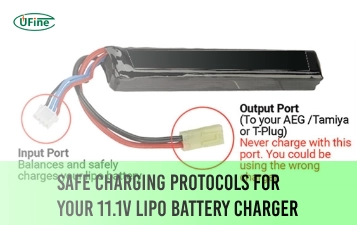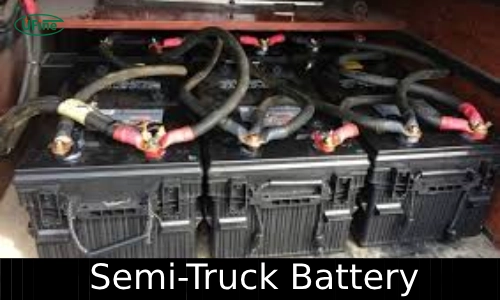Choosing the correct battery for your truck is essential. Semi-truck batteries and regular truck batteries are different. This article will help you understand those differences. By the end, you’ll know which battery is best for your needs.
Part 1. What are semi-truck batteries?
Manufacturers specially design semi-truck batteries to meet the high power demands of large commercial trucks, also known as semi-trailer trucks or 18-wheelers. These trucks require substantial power to start their large diesel engines and to operate various onboard systems and accessories, such as HVAC systems, refrigeration units, and extensive lighting setups. Manufacturers build semi-truck batteries to deliver high-cranking power and deep cycling capabilities, ensuring reliable performance over long distances and in harsh conditions.
Semi-truck Battery Types
There are different types of batteries used in semi trucks. Here are the main ones:
1. Starting Batteries
Starting batteries give a big burst of power to start the engine. They have many thin plates inside. These plates let the battery provide a lot of energy quickly. After starting the engine, the truck’s alternator charges the battery. Starting batteries are suitable for trucks that need a strong start.
2. Deep-Cycle Batteries
Deep-cycle batteries give power over a longer time. They are not just for starting the engine. They power things like lights, fridges, and other equipment when the engine is off. These batteries have thick plates. These plates help the battery last longer and give steady power. Deep-cycle batteries are great for trucks with a lot of extra equipment.
3. Dual-Purpose Batteries
Dual-purpose batteries do both jobs. They help start the engine and give power to other parts. These batteries are a mix of starting and deep-cycle batteries. They are suitable for trucks that need both strong starts and steady energy. Dual-purpose batteries save space because you only need one battery instead of two.
Part 2. Characteristics of semi truck batteries
Capacity and Power
Manufacturers build semi-truck batteries to handle high power demands. They have a high cold cranking amp (CCA) rating, which means they can deliver a powerful burst of energy to start large diesel engines, even in cold weather. These batteries also have a high reserve capacity (RC), allowing them to run multiple electrical systems for extended periods without recharging. This is crucial for long-haul trucks that may operate their lights, HVAC systems, and other accessories while the engine is off.
Durability and Longevity
Manufacturers design semi-truck batteries to be highly durable. They withstand vibrations and shocks from rough road conditions. Manufacturers fortify the internal components to prevent damage, ensuring a longer lifespan. These batteries often feature thicker plates and robust separators, which help them endure frequent deep discharging and recharging cycles. This durability is essential for trucks carrying heavy loads on the road for extended periods.
Size and Weight
Semi-truck batteries are larger and heavier than regular truck batteries. They need to be more significant in order to store more energy and provide the necessary power. The weight of these batteries can be substantial, often requiring robust, reinforced mounting systems to keep them secure. The size and weight are trade-offs needed to ensure the battery can meet the high power and durability requirements of semi-trucks.
Part 3. What are truck batteries?
Manufacturers design truck batteries for smaller, lighter trucks, including pickup trucks and light-duty commercial vehicles. They tailor these batteries to meet the power needs of gasoline or smaller diesel engines and the electrical systems that support daily driving activities. While they must also be reliable and durable, the power demands are generally lower than semi-truck batteries.
Truck Battery Types
There are several common types of batteries used in regular trucks. Understanding the differences can help you choose the right one for your needs.
1. Flooded Lead-Acid Batteries
Flooded lead-acid batteries are the most traditional and widely used type. They contain a liquid electrolyte and require regular maintenance, such as checking water levels and cleaning terminals. These relatively inexpensive batteries provide reliable performance for most regular truck applications. However, they can be sensitive to extreme temperatures and must remain upright to prevent leakage.
2. Absorbent Glass Mat (AGM) Batteries
AGM batteries are sealed lead-acid batteries that use a fiberglass mat to absorb the electrolyte. This design makes them spill-proof and maintenance-free. AGM batteries are known for their durability and ability to provide high power output even in cold weather. They are also more vibration-resistant, making them ideal for trucks operating in rough conditions.
3. Gel Cell Batteries
Gel cell batteries are another type of sealed lead-acid battery. They use a gel-like substance as the electrolyte, which makes them wholly maintenance-free and resistant to leaks. These batteries are highly durable and perform well in extreme temperatures. However, they are more expensive than flooded lead-acid and AGM batteries.
4. Lithium-Ion Batteries
Lithium-ion batteries are becoming more popular in the automotive industry due to their high energy density and long lifespan. These batteries are lightweight, charge quickly, and have a longer cycle life than lead-acid batteries. However, they are significantly more expensive and may only be suitable for some types of regular trucks due to their specific charging requirements and sensitivity to extreme temperatures.
5. Enhanced Flooded Batteries (EFB)
EFB batteries are an improved version of traditional flooded lead-acid batteries. They offer better performance and a longer lifespan, making them suitable for trucks with higher electrical demands. EFB batteries are more resistant to deep discharges and provide reliable starting power, even in challenging conditions.
Part 4. Characteristics of truck batteries
Capacity and Power
Truck batteries for regular trucks have a lower cold cranking amp (CCA) rating than semi-truck batteries. Manufacturers design them to start smaller gasoline or diesel engines. These batteries also have a moderate reserve capacity (RC) to power the truck’s electrical systems, like lights and radios, for shorter periods. Regular truck batteries provide enough power for everyday driving, but they must handle the extreme demands of long-haul trucking.
Durability
Manufacturers build regular truck batteries to be durable, but not to the same extent as semi-truck batteries. They design these batteries to handle typical driving conditions, including occasional bumps and vibrations. These batteries often have reinforced cases and secure internal components to prevent damage from everyday use. However, they may only last briefly or be as resistant to deep discharging cycles as semi-truck batteries.
Size and Weight
Truck batteries for regular trucks are smaller and lighter than those for semi trucks. They need less space and are easier to handle. The reduced size and weight make them suitable for light-duty trucks and pickups, which do not require the extensive power storage of a semi-truck. The compact size makes installation and replacement easier for the average vehicle owner.
Part 5. Differences between semi-truck and truck batteries
Size and Weight
Semi-truck batteries are much larger and heavier than regular truck batteries. They need to store more energy to power large diesel engines and additional equipment in semi-trucks. Regular truck batteries are smaller and lighter, suitable for smaller engines, and have fewer electrical demands. The size and weight of semi-truck batteries make them more robust but more complicated to handle.
Power and Capacity
Semi-truck batteries have a higher cold cranking amp (CCA) rating, meaning they can start big diesel engines even in freezing weather. They also have a higher reserve capacity (RC) to power various truck systems for a longer time. Regular truck batteries have a lower CCA and RC, enough for starting smaller engines and running basic electronics. This difference ensures that semi trucks can handle more demanding tasks.
Durability and Construction
Manufacturers build semi-truck batteries to be more durable. They can withstand heavy vibrations and shocks from long-distance travel and rough roads. These batteries often have thicker plates and sturdy separators to prevent internal damage. Regular truck batteries are also durable, but not to the same extent. They can handle everyday driving conditions but may only last briefly under extreme stress.
Lifespan
Because of their robust construction, semi-truck batteries generally have a longer lifespan. They undergo more deep discharge and recharge cycles without losing performance. Regular truck batteries, while reliable, may endure fewer cycles and can wear out faster under heavy use. This difference means semi truck batteries are more cost-effective over time for long-haul drivers.
Maintenance
Semi-truck batteries require more maintenance due to their larger size and higher power output. Regular checks for water levels and terminal cleanliness are standard. Some semi-truck batteries, like AGM or gel types, are maintenance-free but still need periodic inspection. Regular truck batteries, especially traditional flooded lead-acid types, also need maintenance but are generally easier to manage due to their smaller size.
Cost
Semi-truck batteries are usually more expensive than regular truck batteries. Their higher capacity, durability, and specialized construction contribute to the increased cost. Regular truck batteries are more affordable and sufficient for light-duty use. This cost difference reflects the varying needs and performance requirements of semi trucks versus regular trucks.
Application
Manufacturers specifically design semi-truck batteries for heavy-duty commercial vehicles. They power large engines, run auxiliary equipment, and ensure reliable long-distance performance. Manufacturers make regular truck batteries for light-duty trucks and personal vehicles. They provide enough power for everyday driving and basic electrical systems. Choosing the right battery type depends on the vehicle’s purpose and power needs.
Part 6. FAQs
-
How often should I replace my truck battery?
Most truck batteries need replacement every 3 to 5 years. However, this can vary based on usage, climate, and maintenance. Regularly check your battery’s performance and look for signs of wear, like slow engine starts or dim lights. If you notice these signs, it might be time for a new battery. -
What are the signs of a failing truck battery?
Common signs of a failing truck battery include slow engine cranking, dim headlights, and the battery warning light on your dashboard. You might also notice electrical issues, like problems with the radio or power windows. If your battery is more than three years old and showing these signs, it’s a good idea to get it tested. -
Can extreme weather affect my truck battery?
Yes, extreme weather can significantly impact your truck battery. Cold weather can reduce the battery’s ability to start your engine. In contrast, hot weather can cause the battery fluid to evaporate, leading to internal damage. It’s essential to check your battery’s health before seasons with extreme temperatures. -
How can I maintain my truck battery?
Regular maintenance can extend your truck battery’s life. Keep the battery terminals clean and free of corrosion. Make sure the battery is securely mounted to prevent vibrations. Check the battery fluid level if it’s not sealed, and top it off with distilled water if needed. Regularly test the battery’s voltage and charge it if necessary. -
Is it safe to jump-start a truck battery?
It is generally safe to jump-start a truck battery with the proper precautions. Use jumper cables or a jump starter with the correct voltage. Connect the positive and negative terminals correctly to avoid sparks. After jump-starting, let the engine run for at least 15 minutes to allow the alternator to charge the battery. If your battery frequently needs jump-starting, it’s time to replace it.
Related Tags:
More Articles

Safe Charging Protocols for Your 11.1V LiPo Battery Charger
Safely charge your 11.1V LiPo battery by following proper rates, using safety tools, and avoiding common charging mistakes.
11.1 V LiPo Battery Airsoft: Boosting Field Performance
Upgrade your airsoft gun with an 11.1V LiPo battery for faster firing, longer runtime, and top-tier performance on the battlefield.
Batteries for Trolling Motors Lightweight vs. Leaf Blower Power
Explore the best lightweight trolling motor batteries and how they compare to leaf blower power for performance, portability, and runtime.
What Is a 2C Battery?
Learn what a 2C battery is, how C-rates affect performance, and how to calculate the number of batteries your device needs.
What Battery Does LED Strips Use?
Discover which batteries power LED strips best. Learn about voltage, capacity, battery types, and how to safely power your LED lighting projects.






